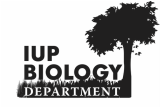|
Welcome to the Lab of Dr. Josiah Townsend, located in 18 Weyandt Hall in the Department of Biology at IUP. Our research emphasizes the inherent connections between systematic biology and conservation, integrating field-based sampling and laboratory analyses into a framework that uses taxonomic inventory and monitoring to generate evolutionary and ecological questions, while promoting education and extension in support of broader conservation goals.
While most of our research is focused in northern Central America, we maintain a dual geographic scope for our research efforts, with ongoing projects locally in Pennsylvania and broader Appalachia. Research in both regions centers on at-risk, fragmented ecosystems that are home to conservation-priority species, particularly amphibians and reptiles. A principle theme of the lab is elucidating the patterns and processes that generate taxonomic diversity, often resulting in taxonomic descriptions of new species and revisions of existing taxa. We apply quantitative species delimitation methods and integrate a variety of lines of evidence to address research questions, including phylogenetics and phylogenomics, microCT-based comparative osteology, bioacoustic analysis of vocalizations, species distribution modeling, and traditional comparative morphology. |
|
Teaching remotely from Honduras during Fall 2020 semester
Townsend Lab News

Atlantihyla melissa - A critically endangered new species of polymorphic stream frog from the montane rainforest of Texiguat, Honduras
Townsend, JH, LA Herrera-B., EP Hofmann, IR Luque-Montes, AN Ross, DJ Dudek, Jr., C Krygeris, JE Duchamp, LD Wilson. 2020. A critically endangered new species of polymorphic stream frog (Anura: Hylidae: Atlantihyla) from the montane rainforest of Refugio de Vida Silvestre Texiguat, Honduras. Vertebrate Zoology 70(4): 731–756. https://doi.org/10.26049/VZ70-4-2020-12
We are proud to present another new endemic species from Texiguat Wildlife Refuge in Honduras, named for Honduran amphibian biologist and Townsend Lab alumnus Isis Melissa Medina-Flores: Atlantihyla melissa. This species is restricted to the montane forest of Texiguat Wildlife Refuge, an important site for endemic herpetofauna in Central America that is threatened by deforestation and development of a hydroelectric dam at the type locality. To delimit this beautiful polymorphic species, we integrated genetic, morphological, and bioacoustic evidence, and captured the cover of Vertebrate Zoology. Many biologists and mountaineering enthusiasts in Honduras know of Melissa, an experienced field biologist whose hard work led to the discovery and description of many new species, including Guifarro’s palm-pitviper (Bothriechis guifarroi) and the centipede snake Tantilla olympia (both endemic to Texiguat), and two salamanders endemic to the Department of Olancho: Nototriton mime and N. picucha. Melissa mysteriously disappeared four years ago while descending from Cerro de las Minas in Celaque National Park, leaving no trace of her fate.
Townsend, JH, LA Herrera-B., EP Hofmann, IR Luque-Montes, AN Ross, DJ Dudek, Jr., C Krygeris, JE Duchamp, LD Wilson. 2020. A critically endangered new species of polymorphic stream frog (Anura: Hylidae: Atlantihyla) from the montane rainforest of Refugio de Vida Silvestre Texiguat, Honduras. Vertebrate Zoology 70(4): 731–756. https://doi.org/10.26049/VZ70-4-2020-12
We are proud to present another new endemic species from Texiguat Wildlife Refuge in Honduras, named for Honduran amphibian biologist and Townsend Lab alumnus Isis Melissa Medina-Flores: Atlantihyla melissa. This species is restricted to the montane forest of Texiguat Wildlife Refuge, an important site for endemic herpetofauna in Central America that is threatened by deforestation and development of a hydroelectric dam at the type locality. To delimit this beautiful polymorphic species, we integrated genetic, morphological, and bioacoustic evidence, and captured the cover of Vertebrate Zoology. Many biologists and mountaineering enthusiasts in Honduras know of Melissa, an experienced field biologist whose hard work led to the discovery and description of many new species, including Guifarro’s palm-pitviper (Bothriechis guifarroi) and the centipede snake Tantilla olympia (both endemic to Texiguat), and two salamanders endemic to the Department of Olancho: Nototriton mime and N. picucha. Melissa mysteriously disappeared four years ago while descending from Cerro de las Minas in Celaque National Park, leaving no trace of her fate.

Recently Dr. Townsend was the guest for #LunchWithAScientist outreach program hosted by the Headwaters Science Institute. You can watch the presentation about new species discovery in the Lenca Highlands HERE

Mito-nuclear discordance driven by incomplete lineage sorting clarifies evolutionary patterns in highland toads
Firneno, Jr., TJ, JR O’Neill, DM Portik, AH Emery, JH Townsend, MK Fujita. 2020. Finding complexity in complexes: assessing the causes of mitonuclear discordance in a problematic species complex of Mesoamerican toads. Molecular Ecology 29(18): 3543–3559. https://doi.org/10.1111/mec.15496
In the latest issue of Molecular Ecology, lab alum TJ Firneno's latest study of the problematic Incilius coccifer complex uses a combination of genome-wide SNP's (ddRADSeq) and mitchondrial DNA fragments to reveals the processes driving discordance between observed patterns of mitochondrial and nuclear evolution and taxonomy. This outstanding contribution was highlighted in the issue with a News and Views article by Streicher and Day (available here).
ABSTRACT - Mitonuclear discordance is a frequently encountered pattern in phylogeographic studies and occurs when mitochondrial and nuclear DNA display conflicting signals. Discordance among these genetic markers can be caused by several factors including confounded taxonomies, gene flow, and incomplete lineage sorting. In this study, we present a strong case of mitonuclear discordance in a species complex of toads (Bufonidae: Incilius coccifer complex) found in the Chortís Block of Central America. To determine the cause of mitonuclear discordance in this complex, we used spatially explicit genetic data to test species limits and relationships, characterize demographic history, and quantify gene flow. We found extensive mitonuclear discordance among the three recognized species within this group, especially in populations within the Chortís Highlands of Honduras. Our data reveal nuclear introgression within the Chortís Highlands populations that was most probably driven by cyclical range expansions due to climatic fluctuations. Though we determined introgression occurred within the nuclear genome, our data suggest that it is not the key factor in driving mitonuclear discordance in the entire species complex. Rather, due to a lack of discernible geographic pattern between mitochondrial and nuclear DNA, as well as a relatively recent divergence time of this complex, we concluded that mitonuclear discordance has been caused by incomplete lineage sorting. Our study provides a framework to test sources of mitonuclear discordance and highlights the importance of using multiple marker types to test species boundaries in cryptic species.
Firneno, Jr., TJ, JR O’Neill, DM Portik, AH Emery, JH Townsend, MK Fujita. 2020. Finding complexity in complexes: assessing the causes of mitonuclear discordance in a problematic species complex of Mesoamerican toads. Molecular Ecology 29(18): 3543–3559. https://doi.org/10.1111/mec.15496
In the latest issue of Molecular Ecology, lab alum TJ Firneno's latest study of the problematic Incilius coccifer complex uses a combination of genome-wide SNP's (ddRADSeq) and mitchondrial DNA fragments to reveals the processes driving discordance between observed patterns of mitochondrial and nuclear evolution and taxonomy. This outstanding contribution was highlighted in the issue with a News and Views article by Streicher and Day (available here).
ABSTRACT - Mitonuclear discordance is a frequently encountered pattern in phylogeographic studies and occurs when mitochondrial and nuclear DNA display conflicting signals. Discordance among these genetic markers can be caused by several factors including confounded taxonomies, gene flow, and incomplete lineage sorting. In this study, we present a strong case of mitonuclear discordance in a species complex of toads (Bufonidae: Incilius coccifer complex) found in the Chortís Block of Central America. To determine the cause of mitonuclear discordance in this complex, we used spatially explicit genetic data to test species limits and relationships, characterize demographic history, and quantify gene flow. We found extensive mitonuclear discordance among the three recognized species within this group, especially in populations within the Chortís Highlands of Honduras. Our data reveal nuclear introgression within the Chortís Highlands populations that was most probably driven by cyclical range expansions due to climatic fluctuations. Though we determined introgression occurred within the nuclear genome, our data suggest that it is not the key factor in driving mitonuclear discordance in the entire species complex. Rather, due to a lack of discernible geographic pattern between mitochondrial and nuclear DNA, as well as a relatively recent divergence time of this complex, we concluded that mitonuclear discordance has been caused by incomplete lineage sorting. Our study provides a framework to test sources of mitonuclear discordance and highlights the importance of using multiple marker types to test species boundaries in cryptic species.

New species of Tantilla from the northern Caribbean Coast of Honduras
When a walk along the train tracks leads to the discovery of a new species of centipede snake...
Abstract.—A new species of Tantilla is described from the Refugio de Vida Silvestre Barras de Cuero y Salado (RVSBCS), on the Caribbean coast of Honduras. Assigned to the Tantilla taeniata group, this species differs from others in this group in color pattern, numbers of scales, measurements, and habitat. An incomplete pale nuchal collar and a pale mediodorsal stripe extending to the proximal edge of the paravertebral rows on the anterior third of the body are present. The lateral extension of the head cap does not completely separate the postocular pale spot from the pale nuchal collar. A pale lateral stripe is present on the adjacent halves of dorsal scale rows 3 and 4. The ventrolateral ground color is much darker than that of the dorsolateral ground color. The ventral + subcaudal number of 244 is the highest figure for the males of species in the group. The RVSBCS is an important coastal protected area in Mesoamerica, due to its significant coastal diversity, including iconic species, in addition to harboring this centipede snake.
Download the full paper HERE

Check out Dr. Townsend's interview on the podcast "Tails from Abroad", from IUP's International Education Office
O'Neill successfully defends thesis, joins Espindola Lab at Maryland
Congratulations to Justin O'Neill, who successfully defended his thesis "Ecological niche modeling in a phylogenetic context: Exploring distributions and contact zones between two Central American leopard frogs (Amphibia: Ranidae)" on 31 July 2020. Justin will be joining the lab of Dr. Anahi Espindola at the University of Maryland this Fall to begin his PhD studies.
Congratulations to Justin O'Neill, who successfully defended his thesis "Ecological niche modeling in a phylogenetic context: Exploring distributions and contact zones between two Central American leopard frogs (Amphibia: Ranidae)" on 31 July 2020. Justin will be joining the lab of Dr. Anahi Espindola at the University of Maryland this Fall to begin his PhD studies.

Revising the taxonomy of a widespread species of glassfrog
Mendoza-Henao, AM, E Arias, JH Townsend, and G Parra-Olea. 2020. Phylogeny-based species delimitation and integrative taxonomic revision of the Hyalinobatrachium fleischmanni species complex, with resurrection of H. viridissimum (Taylor 1942). Systematics and Biodiversity 18(5): 464–484. Download here
A collaborative paper led by doctoral student (now PhD) Angy Mendoza from the lab of Dr. Gabriela Parra-Olea at the National Autonomous University of Mexico has provided a long-awaited revision of a widespread complex of cryptic glassfrogs hidden under the name Hyalinobatrachium fleischmanni. In the paper, published in the journal Systematics and Biodiversity, we present a comprehensive integrative assessment of multilocus phylogenetic relationships, comparative morphology, and bioacoustics, and we conclude to restrict the name H. fleischmanni to populations from eastern Honduras south through Nicaragua and Costa Rica, resurrecting the name H. viridissimum for northern populations, and assigning populations from eastern Costa Rica south through Panama to H. tatayoi.
The study also confirms that populations in the central-western Chortis Block previously referred to as H. fleischmanni may representative of an undescribed species, with a follow up study to assess morphological and bioacoustic variation of the Chortis population underway.
Mendoza-Henao, AM, E Arias, JH Townsend, and G Parra-Olea. 2020. Phylogeny-based species delimitation and integrative taxonomic revision of the Hyalinobatrachium fleischmanni species complex, with resurrection of H. viridissimum (Taylor 1942). Systematics and Biodiversity 18(5): 464–484. Download here
A collaborative paper led by doctoral student (now PhD) Angy Mendoza from the lab of Dr. Gabriela Parra-Olea at the National Autonomous University of Mexico has provided a long-awaited revision of a widespread complex of cryptic glassfrogs hidden under the name Hyalinobatrachium fleischmanni. In the paper, published in the journal Systematics and Biodiversity, we present a comprehensive integrative assessment of multilocus phylogenetic relationships, comparative morphology, and bioacoustics, and we conclude to restrict the name H. fleischmanni to populations from eastern Honduras south through Nicaragua and Costa Rica, resurrecting the name H. viridissimum for northern populations, and assigning populations from eastern Costa Rica south through Panama to H. tatayoi.
The study also confirms that populations in the central-western Chortis Block previously referred to as H. fleischmanni may representative of an undescribed species, with a follow up study to assess morphological and bioacoustic variation of the Chortis population underway.
Dudek successfully defends thesis and receives Outstanding Graduate Research Award, joins Fujita Lab at UTA
A big congratulations to Daniel Dudek, Jr., who successfully defended his thesis "Unraveling the taxonomic confusion of Pacific Coast leopard frogs (Ranidae: Rana: subgenus Pantherana)" on 20 March 2020. Dan also received a 2020 IUP Outstanding Graduate Research Award, in recongition of the high quality of his research and thesis; he is the third member of our lab to receive this honor (Hofmann - 2018, Firneno - 2017). Dan will join fellow lab alum TJ Firneno in the labotatory of Dr. Matt Fujita at the University of Texas at Arlington this Fall to begin his PhD studies.
A big congratulations to Daniel Dudek, Jr., who successfully defended his thesis "Unraveling the taxonomic confusion of Pacific Coast leopard frogs (Ranidae: Rana: subgenus Pantherana)" on 20 March 2020. Dan also received a 2020 IUP Outstanding Graduate Research Award, in recongition of the high quality of his research and thesis; he is the third member of our lab to receive this honor (Hofmann - 2018, Firneno - 2017). Dan will join fellow lab alum TJ Firneno in the labotatory of Dr. Matt Fujita at the University of Texas at Arlington this Fall to begin his PhD studies.

Itgen thesis research published in Herpetological Monographs, delimits new species of salamander
Itgen, MW, SK Sessions, LD Wilson, and JH Townsend. 2020. Integrative systematic revision of Bolitoglossa celaque McCranie & Wilson, with description of a new species from the Lenca Highlands of Honduras. Herpetological Monographs 33: 48–70. Download here
Lab alum Mike Itgen published his thesis research in the most recent issue of Herpetological Monographs, an integrative taxonomic revision of the salamander Bolitoglossa celaque that revealed eastern populations from the Lenca Highlands to be distinct from the population in Cerro Celaque. The study combined molecular, morphological, and osteological data, as well as previously published genome-size data, to delimit the new species, which we name Bolitoglossa copinhorum (= belonging to COPINH), to recognize the organization Consejo Cívico de Organizaciones Populares e Indígenas de Honduras (COPINH; ‘‘Council of Popular and Indigenous Organizations of Honduras’’), founded in March 1993 by Berta Caceres. COPINH is made up of representatives from over 200 indigenous Lenca communities across western Honduras, and seeks to defend and empower Lenca communities to resist exploitation of their lands and natural resources by outside interests. This new species is endemic to the remnant cloud forests of the Sierra Lenca in the departments of Intibucá and La Paz, and will immediately be classified as Endangered on the next update of the IUCN Red List.
Itgen, MW, SK Sessions, LD Wilson, and JH Townsend. 2020. Integrative systematic revision of Bolitoglossa celaque McCranie & Wilson, with description of a new species from the Lenca Highlands of Honduras. Herpetological Monographs 33: 48–70. Download here
Lab alum Mike Itgen published his thesis research in the most recent issue of Herpetological Monographs, an integrative taxonomic revision of the salamander Bolitoglossa celaque that revealed eastern populations from the Lenca Highlands to be distinct from the population in Cerro Celaque. The study combined molecular, morphological, and osteological data, as well as previously published genome-size data, to delimit the new species, which we name Bolitoglossa copinhorum (= belonging to COPINH), to recognize the organization Consejo Cívico de Organizaciones Populares e Indígenas de Honduras (COPINH; ‘‘Council of Popular and Indigenous Organizations of Honduras’’), founded in March 1993 by Berta Caceres. COPINH is made up of representatives from over 200 indigenous Lenca communities across western Honduras, and seeks to defend and empower Lenca communities to resist exploitation of their lands and natural resources by outside interests. This new species is endemic to the remnant cloud forests of the Sierra Lenca in the departments of Intibucá and La Paz, and will immediately be classified as Endangered on the next update of the IUCN Red List.

Townsend Lab students present their amphibian research at National Autonomous University of Honduras in Valle de Sula
One of the highlights of the lab's 2019 Honduras Expedition was organizing and presenting the symposium “Patterns of Evolutionary Diversification in Amphibians from Honduras: Challenges, Advances, and Opportunities” at UNAH-VS. Presenters included undergraduates Esbeiry Cordova-Ortiz and Ayla Ross and graduate students Daniel Dudek, Jr. and Justin O’Neill, as well as lab alum TJ Firneno. All students presented results of their research projects based in Honduras, although for most it was the first time in the country or interacting with our in-country collaborators face to face.
You can read in IUP's news release, written prior to the trip.
One of the highlights of the lab's 2019 Honduras Expedition was organizing and presenting the symposium “Patterns of Evolutionary Diversification in Amphibians from Honduras: Challenges, Advances, and Opportunities” at UNAH-VS. Presenters included undergraduates Esbeiry Cordova-Ortiz and Ayla Ross and graduate students Daniel Dudek, Jr. and Justin O’Neill, as well as lab alum TJ Firneno. All students presented results of their research projects based in Honduras, although for most it was the first time in the country or interacting with our in-country collaborators face to face.
You can read in IUP's news release, written prior to the trip.

Check out our lab group recently featured in two articles in the Pittsburgh Tribune-Review!
IUP team to present research on biodiversity in Honduras
IUP professor named as a Fulbright scholar, headed to Honduras
IUP team to present research on biodiversity in Honduras
IUP professor named as a Fulbright scholar, headed to Honduras

Townsend named Fulbright Scholar, will spend 2019-20 Academic Year in Honduras
Dr. Townsend has been selected for a 2019–20 Fulbright US Scholar grant! As a Fulbright recipient, Townsend will spend the 2019–20 academic year in Honduras working at Zamorano Agricultural University and the National Autonomous University of Honduras–Valle de Sula (UNAH). He will divide his time between conducting research leading to the discovery of new species of amphibians and reptiles and to support national biodiversity conservation initiatives, while teaching classes in ecology and biodiversity and offering professional development workshops for biology faculty and students in the country.
“A Fulbright grant is one of the most prestigious and competitive grants that a faculty can earn,” IUP Provost and Vice President for Academic Affairs Timothy Moerland said. “It’s extremely gratifying to see a faculty member like Dr. Townsend, who continues to demonstrate such a strong commitment to research and teaching, be selected for this honor. We are very proud of him and know that his research in Honduras will continue to enrich the lives of our students as well as add to the ongoing work of the global community of scientists.”
For more details, you can check out IUP's news release and the a story in the Pittsburgh Tribune Review.
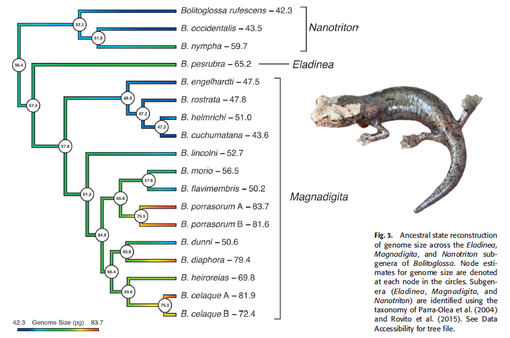
Itgen leads study revealing record-setting genome sizes among Central American salamanders
Itgen, MW, P Prša, R Janža, L Skubic, JH Townsend, A Kladnik, L Bizjak Mali, and SK Sessions. 2019. Genome size diversification in Central American bolitoglossine salamanders (Caudata; Plethodontidae). Copeia 107(3): 560–566. Download here
In a recent paper published in Copeia, lab alum Mike Itgen presented results of a collaborative project examining the genome sizes in six species of Honduran salmanders. Some take-aways from the paper include:
- Genome sizes in Bolitoglossa range from 42-84 picograms, a 42-pg range that is equivalent to the size of about 14 human genomes
- Six mountain-top endemic species have genomes larger than any previously reported for the genus Bolitoglossa OR for the family Plenthodontidae
- Nototriton picucha, a single site endemic from eastern Honduras, has a moderate-sized genome relative to the rest of the family Plethodontidae
- Our evidence from two sister lineages (B. celaque A and B) suggest genome size increases can occur rapidly and independently from changes in sequence structure of functional genes
- Our evidence from Bolitoglossa (Nanotriton) nympha supports the presence of enucleated RBCs as a synapomorphy for the miniaturized subgenus Nanotriton
Itgen, MW, P Prša, R Janža, L Skubic, JH Townsend, A Kladnik, L Bizjak Mali, and SK Sessions. 2019. Genome size diversification in Central American bolitoglossine salamanders (Caudata; Plethodontidae). Copeia 107(3): 560–566. Download here
In a recent paper published in Copeia, lab alum Mike Itgen presented results of a collaborative project examining the genome sizes in six species of Honduran salmanders. Some take-aways from the paper include:
- Genome sizes in Bolitoglossa range from 42-84 picograms, a 42-pg range that is equivalent to the size of about 14 human genomes
- Six mountain-top endemic species have genomes larger than any previously reported for the genus Bolitoglossa OR for the family Plenthodontidae
- Nototriton picucha, a single site endemic from eastern Honduras, has a moderate-sized genome relative to the rest of the family Plethodontidae
- Our evidence from two sister lineages (B. celaque A and B) suggest genome size increases can occur rapidly and independently from changes in sequence structure of functional genes
- Our evidence from Bolitoglossa (Nanotriton) nympha supports the presence of enucleated RBCs as a synapomorphy for the miniaturized subgenus Nanotriton
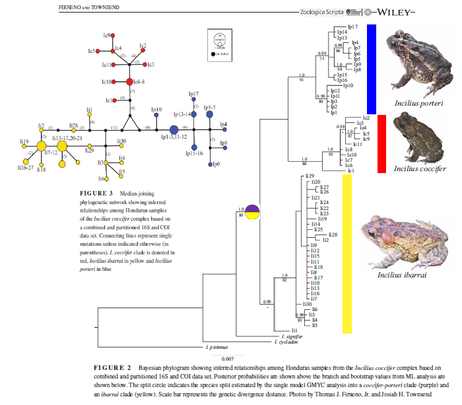
Firneno thesis research examining species boundaries in Mesoamerican highland toads published in Zoologica Scripta
Firneno, Jr., TJ, and JH Townsend. 2019. Integrative evaluation of species boundaries in sympatric and parapatric populations of Mesoamerican toads (Bufonidae: Incilius coccifer group). Zoologica Scripta 48(4): 454–465. Download here
The first comprehensive evaluation of a taxonomically-debated complex of Mesoamerican highland toads was published by Firneno and Townsend in a recent issue of the journal Zoologica Scripta. The Incilius coccifer complex in Honduras is comprised of three putative taxa: I. coccifer, I. ibarrai and I. porteri. The taxonomy of the I. coccifer complex has been a source of debate among specialists, with some recognizing three species, while others choose to recognize one widespread taxon. To assess species boundaries and evaluate the taxonomic structure for the I. coccifer complex, we utilized a combination of comprehensive field sampling, molecular phylogenetics and macroecological modelling. Using 58 samples representing all three putative taxa, we generated sequence data from the mitochondrial loci 16S and COI in order to assess genetic diversity and phylogenetic relationships, and tested putative species boundaries using General Mixed Yule‐Coalescent models. To evaluate macroecological differences in the distribution of putative taxa, we utilized maximum entropy modelling and identified areas of suitable and non‐suitable habitat, as well as identifying potential areas of overlap between species habitats. We recovered three clades that broadly correspond to the three named taxa that, while being monophyletic, are separated by relatively small genetic distances. Species distribution models revealed that I. coccifer is macroecologically different than the other two taxa, but that I. ibarrai and I. porteri are highly similar. We uncovered cases of sympatry between pairs of species in at least three localities in Honduras, suggesting the potential for hybridization in these closely related lineages.
Firneno, Jr., TJ, and JH Townsend. 2019. Integrative evaluation of species boundaries in sympatric and parapatric populations of Mesoamerican toads (Bufonidae: Incilius coccifer group). Zoologica Scripta 48(4): 454–465. Download here
The first comprehensive evaluation of a taxonomically-debated complex of Mesoamerican highland toads was published by Firneno and Townsend in a recent issue of the journal Zoologica Scripta. The Incilius coccifer complex in Honduras is comprised of three putative taxa: I. coccifer, I. ibarrai and I. porteri. The taxonomy of the I. coccifer complex has been a source of debate among specialists, with some recognizing three species, while others choose to recognize one widespread taxon. To assess species boundaries and evaluate the taxonomic structure for the I. coccifer complex, we utilized a combination of comprehensive field sampling, molecular phylogenetics and macroecological modelling. Using 58 samples representing all three putative taxa, we generated sequence data from the mitochondrial loci 16S and COI in order to assess genetic diversity and phylogenetic relationships, and tested putative species boundaries using General Mixed Yule‐Coalescent models. To evaluate macroecological differences in the distribution of putative taxa, we utilized maximum entropy modelling and identified areas of suitable and non‐suitable habitat, as well as identifying potential areas of overlap between species habitats. We recovered three clades that broadly correspond to the three named taxa that, while being monophyletic, are separated by relatively small genetic distances. Species distribution models revealed that I. coccifer is macroecologically different than the other two taxa, but that I. ibarrai and I. porteri are highly similar. We uncovered cases of sympatry between pairs of species in at least three localities in Honduras, suggesting the potential for hybridization in these closely related lineages.
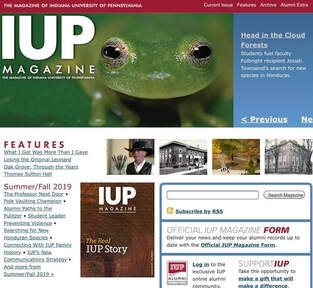
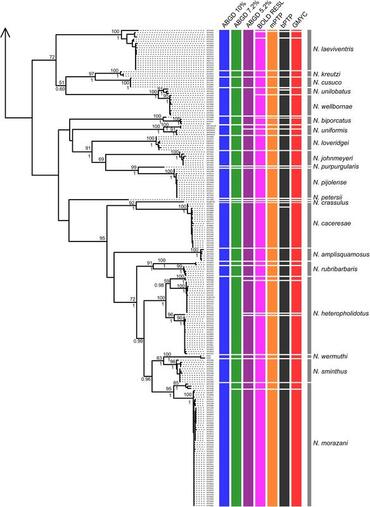
Using DNA barcodes to reveal hidden diversity in Mesoamerican anoles
Hofmann, EP, KE Nicholson, IR Luque-Montes, G Köhler, C Cerrato-Mendoza, M Medina-Flores, LD Wilson, and JH Townsend. 2019. Cryptic diversity, but to what extent? Discordance between single-locus species delimitation methods within mainland anoles (Squamata: Dactyloidae) from Northern Central America. Frontiers in Genetics 10: 11 (1–13). Download here
In the third major paper from his MS thesis work, Erich Hofmann led a comprehensive examination of species-level diversity among Chortis Block anoles using a comparative set of DNA barcode-based species delimitation methods, which we recently published in the journal Frontiers In Genetics. In this paper, we explore diversity of mainland species of anole lizards from the Chortís Block biogeographical province of northern Central America using a DNA barcoding approach, generating and analyzing cytochrome oxidase subunit I (COI) sequences for over 400 samples assignable to 33 of 38 (86.8%) native and one introduced mainland species. We subsequently tested the effects different models of nucleotide substitution, different species-delimitation algorithms, and reducing our dataset had on species delimitation estimates. We used two distance-based (ABGD, RESL) and three tree-based (bPTP, mPTP, GMYC) analyses on both the full dataset and a dataset consisting only of unique halotypes.
From 34 nominal taxa, analyses of the full dataset recovered between 34 and 64 operational taxonomic units (OTUs), while analyses of the reduced dataset inferred between 36 and 59. Reassigning individuals to either mPTP-inferred or ABGD clustered (7.2% threshold) groups improved the detection of a barcoding gap across three different models of nucleotide substitution, removing overlap between intra- and interspecific distances. Our results highlight the underestimated diversity of mainland Chortís Block anoles, but the lack of congruence between analyses demonstrates the importance of considering multiple analytical methods when dealing with single-locus datasets. We recommend future studies consider the effects of different models of nucleotide substitution on proposed barcoding gaps, as well as the effect reducing a dataset to unique haplotypes may have on proposed diversity estimates.
Hofmann, EP, KE Nicholson, IR Luque-Montes, G Köhler, C Cerrato-Mendoza, M Medina-Flores, LD Wilson, and JH Townsend. 2019. Cryptic diversity, but to what extent? Discordance between single-locus species delimitation methods within mainland anoles (Squamata: Dactyloidae) from Northern Central America. Frontiers in Genetics 10: 11 (1–13). Download here
In the third major paper from his MS thesis work, Erich Hofmann led a comprehensive examination of species-level diversity among Chortis Block anoles using a comparative set of DNA barcode-based species delimitation methods, which we recently published in the journal Frontiers In Genetics. In this paper, we explore diversity of mainland species of anole lizards from the Chortís Block biogeographical province of northern Central America using a DNA barcoding approach, generating and analyzing cytochrome oxidase subunit I (COI) sequences for over 400 samples assignable to 33 of 38 (86.8%) native and one introduced mainland species. We subsequently tested the effects different models of nucleotide substitution, different species-delimitation algorithms, and reducing our dataset had on species delimitation estimates. We used two distance-based (ABGD, RESL) and three tree-based (bPTP, mPTP, GMYC) analyses on both the full dataset and a dataset consisting only of unique halotypes.
From 34 nominal taxa, analyses of the full dataset recovered between 34 and 64 operational taxonomic units (OTUs), while analyses of the reduced dataset inferred between 36 and 59. Reassigning individuals to either mPTP-inferred or ABGD clustered (7.2% threshold) groups improved the detection of a barcoding gap across three different models of nucleotide substitution, removing overlap between intra- and interspecific distances. Our results highlight the underestimated diversity of mainland Chortís Block anoles, but the lack of congruence between analyses demonstrates the importance of considering multiple analytical methods when dealing with single-locus datasets. We recommend future studies consider the effects of different models of nucleotide substitution on proposed barcoding gaps, as well as the effect reducing a dataset to unique haplotypes may have on proposed diversity estimates.
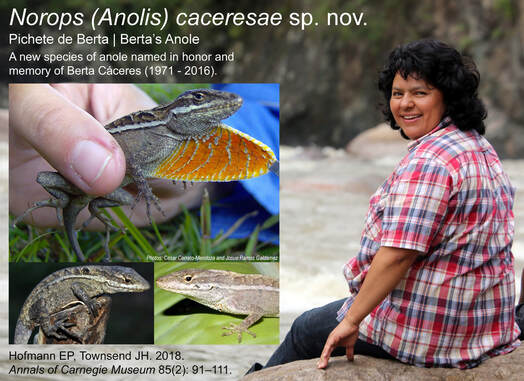
Hofmann thesis research reveals new species of Honduran anole, named in honor of Berta Caceres
Hofmann, EP, and JH Townsend. 2018. A cryptic new species of anole (Squamata: Dactyloidae), previously referred to as Anolis crassulus Cope, 1864, from the Lenca Highlands of Honduras. Annals of the Carnegie Museum 85(2): 91–111. Download here
In the second major paper resulting from his award-winning thesis research, Erich Hofmann led a study to delimit a new species of anole from the Lenca Highlands region of Honduras, which we named Norops caceresae, in honor of the late Berta Caceres. The article appeared in the Annals of the Carnegie Museum and follows up on our paper in BMC Evolutionary Biology, which showed the molecular and biogeographic justification for recognizing the new species, by presenting a comprehensive examination of the morphology of crassulus-like anoles in Mesoamerica.
Berta's Anole (Norops caceresae) is endemic to the Lenca Highlands of Honduras, and we chose the name as a small token in honor and memory of Berta Isabel Cáceres Flores, a Lencan indigenous rights activist, founder of COPINH (Consejo Cívico de Organizaciones Populares e Indígenas de Honduras/National Council of Popular and Indigenous Organizations of Honduras), and winner of the Goldman Environmental Prize in 2015. She was assassinated in her home in March 2016 in retaliation for her successful effort to halt the building of the Agua Zarca dam on the sacred Rio Gualcarque in western Honduras. In November 2018, seven men were convicted as part of Cáceres's murder, and nine total have been arrested (including the former CEO of the firm behind the project to build the dam). Berta Cáceres is one of dozens of Honduran environmental and indigenous rights activists who have been murdered in retaliation for fighting against exploitation of indigenous peoples and natural resources. Please take the time to read about Berta and her activism at the links below.
https://www.goldmanprize.org/recipient/berta-caceres/
https://copinh.org/
http://bertacaceres.org/
https://en.wikipedia.org/wiki/Berta_C%C3%A1ceres
https://news.mongabay.com/…/7-convicted-of-killing-hondura…/
Hofmann, EP, and JH Townsend. 2018. A cryptic new species of anole (Squamata: Dactyloidae), previously referred to as Anolis crassulus Cope, 1864, from the Lenca Highlands of Honduras. Annals of the Carnegie Museum 85(2): 91–111. Download here
In the second major paper resulting from his award-winning thesis research, Erich Hofmann led a study to delimit a new species of anole from the Lenca Highlands region of Honduras, which we named Norops caceresae, in honor of the late Berta Caceres. The article appeared in the Annals of the Carnegie Museum and follows up on our paper in BMC Evolutionary Biology, which showed the molecular and biogeographic justification for recognizing the new species, by presenting a comprehensive examination of the morphology of crassulus-like anoles in Mesoamerica.
Berta's Anole (Norops caceresae) is endemic to the Lenca Highlands of Honduras, and we chose the name as a small token in honor and memory of Berta Isabel Cáceres Flores, a Lencan indigenous rights activist, founder of COPINH (Consejo Cívico de Organizaciones Populares e Indígenas de Honduras/National Council of Popular and Indigenous Organizations of Honduras), and winner of the Goldman Environmental Prize in 2015. She was assassinated in her home in March 2016 in retaliation for her successful effort to halt the building of the Agua Zarca dam on the sacred Rio Gualcarque in western Honduras. In November 2018, seven men were convicted as part of Cáceres's murder, and nine total have been arrested (including the former CEO of the firm behind the project to build the dam). Berta Cáceres is one of dozens of Honduran environmental and indigenous rights activists who have been murdered in retaliation for fighting against exploitation of indigenous peoples and natural resources. Please take the time to read about Berta and her activism at the links below.
https://www.goldmanprize.org/recipient/berta-caceres/
https://copinh.org/
http://bertacaceres.org/
https://en.wikipedia.org/wiki/Berta_C%C3%A1ceres
https://news.mongabay.com/…/7-convicted-of-killing-hondura…/
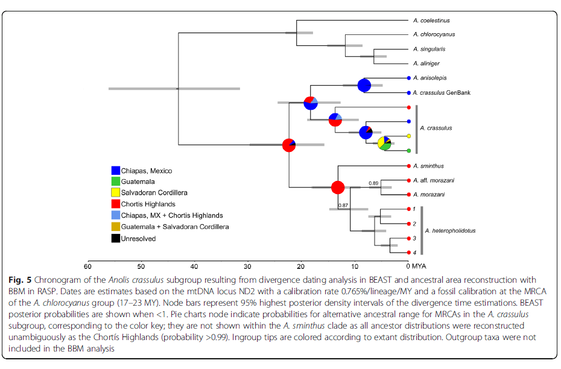
Study of evolutionary diversification of a cryptic radiation of highland anoles published in BMC Evolutionary Biology
Hofmann, EP, and JH Townsend. 2017. Origins and biogeography of the Anolis crassulus subgroup (Squamata: Dactyloidae) in the highlands of Nuclear Central America. BMC Evolutionary Biology 17: 267. Download here
A portion of the thesis work completed by Townsend Lab alumni Erich Hofmann has been published in the journal BMC Evolutionary Biology, and is available for free download here: http://rdcu.be/C2pY. This paper brings some long-awaited clarity to the Anolis crassulus subgroup, a clade of lizards that has long frustrated taxonomists (see quotes below), and, among other things, reveals the following:
Hofmann, EP, and JH Townsend. 2017. Origins and biogeography of the Anolis crassulus subgroup (Squamata: Dactyloidae) in the highlands of Nuclear Central America. BMC Evolutionary Biology 17: 267. Download here
A portion of the thesis work completed by Townsend Lab alumni Erich Hofmann has been published in the journal BMC Evolutionary Biology, and is available for free download here: http://rdcu.be/C2pY. This paper brings some long-awaited clarity to the Anolis crassulus subgroup, a clade of lizards that has long frustrated taxonomists (see quotes below), and, among other things, reveals the following:
- Populations of lizards called Anolis (Norops) crassulus from Intibuca, La Paz, and Lempira represent a new species.
- The Honduran lineage of Anolis crassulus diverged from other lineages approximately 13 million years ago.
- Cladogenesis in the A. crassulus subgroup began approximately 22 million years ago, with the common ancestor originating in the Chortis Block.
- Recognition of the species Anolis heteropholidotus, A. morazani, A. rubribarbaris, A. sminthus, and A. wermuthi is supported.
- Anolis heteropholidotus contains at least four allopatric mitochondrial lineages.
- Cryptic, allopatric lineages were uncovered that are sister lineages to A. morazani (in the Sierra de Agalta) and A. rubribarbaris (in the Guajiquiro region of La Paz).
- John R. Meyer & Larry D. Wilson (1971): “The inter-relationships of the populations… [of the crassulus group] are exceedingly complex, and… we are unable to suggest a satisfactory arrangement.”
- Carl S. Lieb (1981): “The resolution of the tremendous taxonomic problems raised by the schiedei [sic] species group, together with… the Anolis crassulus radiation is probably the most important single problem facing Anolis systematics.”
- James R. McCranie, Larry D. Wilson, & Kenneth L. Williams (1992): “Clearly, a thorough analysis of crassulus-like specimens from throughout their range from western Chiapas to northern El Salvador and southwestern Honduras is sorely needed.”
- James R. McCranie & Gunther Köhler (2015): “…a study of the N. crassulus-like populations with strongly keeled ventral scales from throughout their range from western Chiapas, Mexico, to northwestern El Salvador and southwestern and central Honduras is needed.”

Integrative taxonomy reveals a new species from Honduras: The Lenca Leopard Frog, Rana lenca
Luque-Montes, IR, JD Austin, KD Weinfurther, LD Wilson, EP Hofmann, and JH Townsend. 2018. An integrative assessment of the taxonomic status of putative hybrid leopard frogs (Anura: Ranidae) from the Chortís Highlands of Central America, with description of a new species. Systematics and Biodiversity 16(4): 340–356. Download here
After more than 10 years of work, Ileana Luque-Montes and our team have published an integrative assessment of populations of Honduran highland leopard frogs that had previously been referred to as hybrids of two larger species of lowland leopard frogs. The paper recently appeared in the journal Systematics and Biodiversity, and is the result of Luque-Montes' MS research at the University of Florida, as well as contributions from IUP Biology Honors student Kayla Weinfurther. Using multilocus phylogenetics, macroecological modeling, bioacoustics, and comparative morphology, we showed that, rather than being hybrid populations, these frogs actually represent a new species, which we name Rana lenca, in honor of the indigenous Lenca people of the same highlands were this frog is endemic.
Luque-Montes, IR, JD Austin, KD Weinfurther, LD Wilson, EP Hofmann, and JH Townsend. 2018. An integrative assessment of the taxonomic status of putative hybrid leopard frogs (Anura: Ranidae) from the Chortís Highlands of Central America, with description of a new species. Systematics and Biodiversity 16(4): 340–356. Download here
After more than 10 years of work, Ileana Luque-Montes and our team have published an integrative assessment of populations of Honduran highland leopard frogs that had previously been referred to as hybrids of two larger species of lowland leopard frogs. The paper recently appeared in the journal Systematics and Biodiversity, and is the result of Luque-Montes' MS research at the University of Florida, as well as contributions from IUP Biology Honors student Kayla Weinfurther. Using multilocus phylogenetics, macroecological modeling, bioacoustics, and comparative morphology, we showed that, rather than being hybrid populations, these frogs actually represent a new species, which we name Rana lenca, in honor of the indigenous Lenca people of the same highlands were this frog is endemic.
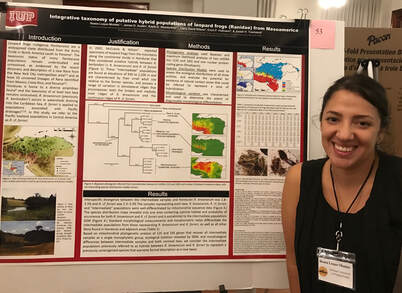
Townsend Lab presentations at the 2017 Three Rivers Evolution Event
Townsend Lab research was featured during the Inaugural Three Rivers Evolution Event, held on September 9, 2017, at the University of Pittsburgh. The event was sponsored by the Society for Molecular Biology and Evolution and the American Society of Naturalists and featured 48 oral and 63 poster presentations by faculty, postdocs, and students from 38 institutions from throughout the northeast. Townsend presented collaborative research with Lab Alumnus Erich Hofmann, in an oral presentation entitled “Evolution of a nonadaptive radiation of Mesoamerican highland anoles (Anolis crassulus subgroup).” Townsend Lab associate and IUP instructor Ileana Luque-Montes also received a travel award from the conference organizers to present her poster “Intergrative taxonomy of putative hybrid populations of leopard frogs (Ranidae) from Mesoamerica.” This project, led by Luque-Montes, was completed in collaboration with Townsend and two former IUP students, Erich Hofmann and Kayla Weinfurther, along with researchers from the University of Florida and Honduras. For a summary of IUP Biology's participation at TREE, check out the IUP news story here.
Townsend Lab research was featured during the Inaugural Three Rivers Evolution Event, held on September 9, 2017, at the University of Pittsburgh. The event was sponsored by the Society for Molecular Biology and Evolution and the American Society of Naturalists and featured 48 oral and 63 poster presentations by faculty, postdocs, and students from 38 institutions from throughout the northeast. Townsend presented collaborative research with Lab Alumnus Erich Hofmann, in an oral presentation entitled “Evolution of a nonadaptive radiation of Mesoamerican highland anoles (Anolis crassulus subgroup).” Townsend Lab associate and IUP instructor Ileana Luque-Montes also received a travel award from the conference organizers to present her poster “Intergrative taxonomy of putative hybrid populations of leopard frogs (Ranidae) from Mesoamerica.” This project, led by Luque-Montes, was completed in collaboration with Townsend and two former IUP students, Erich Hofmann and Kayla Weinfurther, along with researchers from the University of Florida and Honduras. For a summary of IUP Biology's participation at TREE, check out the IUP news story here.

Hofmann wins 2017 IUP Outstanding Graduate Research Award, joins Parkinson Lab at Clemson
Masters student Erich Hofmann was awarded the 2017 IUP Outstanding Graduate Research Award for his thesis "Cryptic diversity and phenotypic stasis in a complex of highland anoles (Squamata: Dactyloidae: Norops crassulus species subgroup)", which he successfully defended this Spring. Erich will be heading to Clemson University where he will join the Parkinson Lab for his PhD studies on the evolution of Neotropical pitvipers and their venoms, fully supported by a Trustees Doctoral Fellowship. Exemplary work by Erich over the past two years, he has set a very high bar for future students!

Townsend Lab study on microsympatry in cryptic tropical salamanders
Hess, AJ, MW Itgen, TJ Firneno, JC Nifong, and JH Townsend. 2016. Microsympatry in cryptic lowland salamanders (Caudata: Plethodontidae: Bolitoglossa subgenus Nanotriton) from northwestern Honduras: implications for taxonomy and regional biogeography. Journal of Zoological Systematics and Evolutionary Research (Online Early): doi:10.1111/jzs.12151.
Abstract: The taxonomy of the diminutive bolitoglossine salamanders of the subgenus Nanotriton has previously been a source of confusion among specialists. At various times, at least three different species of Nanotriton have been reported to occur in Honduras: Bolitoglossa nympha, B. occidentalis, and B. rufescens. Phylogenetic analysis of 16S and cyt b from samples from three localities in Honduras (departments of Yoro, Copán, and Cortés) confirm that most populations are assignable to B. nympha. Nine samples collected from a single locality on the northern slope of the Sierra de Omoa, between 120–190 m in elevation, were found to represent two distinct taxa: B. nympha and B. rufescens. Field examination of these nine specimens found them to be morphologically indistinguishable, including a lack of maxillary teeth in all specimens. As such in situ identification of the two species in northwestern Honduras is problematic given the occurrence of the two taxa in microsympatry in at least one locality. The discovery of yet another divergent lineage of B. rufescens highlights the need for a taxonomic reassessment within this species complex.
Hess, AJ, MW Itgen, TJ Firneno, JC Nifong, and JH Townsend. 2016. Microsympatry in cryptic lowland salamanders (Caudata: Plethodontidae: Bolitoglossa subgenus Nanotriton) from northwestern Honduras: implications for taxonomy and regional biogeography. Journal of Zoological Systematics and Evolutionary Research (Online Early): doi:10.1111/jzs.12151.
Abstract: The taxonomy of the diminutive bolitoglossine salamanders of the subgenus Nanotriton has previously been a source of confusion among specialists. At various times, at least three different species of Nanotriton have been reported to occur in Honduras: Bolitoglossa nympha, B. occidentalis, and B. rufescens. Phylogenetic analysis of 16S and cyt b from samples from three localities in Honduras (departments of Yoro, Copán, and Cortés) confirm that most populations are assignable to B. nympha. Nine samples collected from a single locality on the northern slope of the Sierra de Omoa, between 120–190 m in elevation, were found to represent two distinct taxa: B. nympha and B. rufescens. Field examination of these nine specimens found them to be morphologically indistinguishable, including a lack of maxillary teeth in all specimens. As such in situ identification of the two species in northwestern Honduras is problematic given the occurrence of the two taxa in microsympatry in at least one locality. The discovery of yet another divergent lineage of B. rufescens highlights the need for a taxonomic reassessment within this species complex.

Two new species of cryptic moss salamanders from the Cordillera Nombre de Dios in Honduras
Townsend, JH. 2016. Taxonomic revision of Nototriton barbouri (Schmidt) (Caudata: Plethodontidae), with description of two new species of moss salamanders from the Cordillera Nombre de Dios, Honduras. Zootaxa 4196(4): 511–528.
Abstract: Moss salamanders (genus Nototriton) are represented in northern Central America by nine putative species: N. barbouri, N. brodiei, N. lignicola, N. limnospectator, N. mime, N. picucha, N. saslaya, N. stuarti, and N. tomamorum. I estimate the phylogenetic relationships for these species based on data from three mitochondrial gene fragments (16S, cytochrome b, and COI), and compare morphological variation among putative taxa. As evidenced here and in previous studies, the taxon N. barbouri is paraphyletic with respect to populations from the Cordillera Nombre de Dios in northern Honduras. I restricted this taxon to populations from the Sierra de Sulaco in central Yoro, Honduras, and describe two new species from the Cordillera Nombre de Dios.
Townsend, JH. 2016. Taxonomic revision of Nototriton barbouri (Schmidt) (Caudata: Plethodontidae), with description of two new species of moss salamanders from the Cordillera Nombre de Dios, Honduras. Zootaxa 4196(4): 511–528.
Abstract: Moss salamanders (genus Nototriton) are represented in northern Central America by nine putative species: N. barbouri, N. brodiei, N. lignicola, N. limnospectator, N. mime, N. picucha, N. saslaya, N. stuarti, and N. tomamorum. I estimate the phylogenetic relationships for these species based on data from three mitochondrial gene fragments (16S, cytochrome b, and COI), and compare morphological variation among putative taxa. As evidenced here and in previous studies, the taxon N. barbouri is paraphyletic with respect to populations from the Cordillera Nombre de Dios in northern Honduras. I restricted this taxon to populations from the Sierra de Sulaco in central Yoro, Honduras, and describe two new species from the Cordillera Nombre de Dios.

Two new species of Mesoamerican anoles named for pioneers of Honduran herpetology, Wilson and McCranie
Köhler, G, JH Townsend, and CBP Petersen 2016. Taxonomic revision of Norops tropidonotus (Peters 1863), with the resurrection of N. spilorhipus (Alvarez del Toro & Smith 1956) and description of two new species. Mesoamerican Herpetology 3(1): 8–41.
A new paper by Gunther Köhler, Joe Townsend, and Claus Bo P. Petersen presents a taxonomic revision of the widespread anole Norops tropidonotus, and presents evidence for the resurrection of N. spilorhipis (Álvarez del Toro and Smith, 1956) and the description of two new species: Norops mccraniei, a primarily pine-oak forest inhabitant endemic to the Chortis Block, and N. wilsoni, a lowland rainforest edge inhabitant endemic to the northern slopes of the Cordillera Nombre de Dios.
These two new species were named for Larry David Wilson and James Randy McCranie, the pioneering herpetologists that have worked to document the amphibians and reptiles of Honduras since 1967 and 1980, respectively. There combined work includes the description of over 100 endemic species, many of which are endemic to the country's cloud forests and offshore islands.
The paper was published in the open access journal Mesoamerican Herpetology, and is available for download here.
Köhler, G, JH Townsend, and CBP Petersen 2016. Taxonomic revision of Norops tropidonotus (Peters 1863), with the resurrection of N. spilorhipus (Alvarez del Toro & Smith 1956) and description of two new species. Mesoamerican Herpetology 3(1): 8–41.
A new paper by Gunther Köhler, Joe Townsend, and Claus Bo P. Petersen presents a taxonomic revision of the widespread anole Norops tropidonotus, and presents evidence for the resurrection of N. spilorhipis (Álvarez del Toro and Smith, 1956) and the description of two new species: Norops mccraniei, a primarily pine-oak forest inhabitant endemic to the Chortis Block, and N. wilsoni, a lowland rainforest edge inhabitant endemic to the northern slopes of the Cordillera Nombre de Dios.
These two new species were named for Larry David Wilson and James Randy McCranie, the pioneering herpetologists that have worked to document the amphibians and reptiles of Honduras since 1967 and 1980, respectively. There combined work includes the description of over 100 endemic species, many of which are endemic to the country's cloud forests and offshore islands.
The paper was published in the open access journal Mesoamerican Herpetology, and is available for download here.
Itgen successfully defends MSc thesis, joining the Mueller Lab at Colorado State U. this Fall
Congratulations to Mike Itgen for the successful defense of his thesis "Taxonomic revisions of two Magnadigita (Caudata: Plethodontidae: Bolitoglossa) from Honduras, on Wednesday, 15 June 2016. Mike will be joining the lab of Dr. Rachel Mueller at Colorado State University this Fall to begin his PhD studies.
Congratulations to Mike Itgen for the successful defense of his thesis "Taxonomic revisions of two Magnadigita (Caudata: Plethodontidae: Bolitoglossa) from Honduras, on Wednesday, 15 June 2016. Mike will be joining the lab of Dr. Rachel Mueller at Colorado State University this Fall to begin his PhD studies.
Hess successfully defends MSc thesis, heading to Bonett Lab at U. Tulsa
Another of our crew has passed his thesis defense, big congratulations to Alexander Hess for successfully defending his thesis "Community ecology and evolution of lungless salamander ensembles using temperate and tropical models" on Wednesday, 23 March 2016. Alex will be joining the lab of Dr. Ron Bonett at the University of Tulsa this Fall to begin his PhD studies.
Another of our crew has passed his thesis defense, big congratulations to Alexander Hess for successfully defending his thesis "Community ecology and evolution of lungless salamander ensembles using temperate and tropical models" on Wednesday, 23 March 2016. Alex will be joining the lab of Dr. Ron Bonett at the University of Tulsa this Fall to begin his PhD studies.
Weinfurther honored with 2016 Biology Outstanding Student Award and Cynthia Sushak Biology Fund for Excellence Award
Longtime Lab member Kayla Weinfurther was honored as the recipient of both the 2016 Biology Outstanding Student Award and Cynthia Sushak Undergraduate Biology Fund for Excellence Award at the Biology Department awards ceremony on Friday, 18 March 2016. Kayla was recognized for her contributions in the classroom and the lab, based on her ongoing work looking at the evolutionary diversification of Mesoamerican true frogs. Congratulations Kayla!
Longtime Lab member Kayla Weinfurther was honored as the recipient of both the 2016 Biology Outstanding Student Award and Cynthia Sushak Undergraduate Biology Fund for Excellence Award at the Biology Department awards ceremony on Friday, 18 March 2016. Kayla was recognized for her contributions in the classroom and the lab, based on her ongoing work looking at the evolutionary diversification of Mesoamerican true frogs. Congratulations Kayla!
Firneno successfully defends MSc thesis, heading to UTA to join the Fujita Lab
Townsend Lab everyman and soon-to-be alumnus T.J. Firneno successfully defended his MSc thesis "Integrative assessment of species boundaries in Mesoamerican toads (Incilius coccifer complex)" on Friday, 26 February 2016. Congratulations T.J, excellent job! TJ will be joining the lab of Dr. Matt Fujita at the University of Texas at Arlington this Fall to begin his PhD studies.
Townsend Lab everyman and soon-to-be alumnus T.J. Firneno successfully defended his MSc thesis "Integrative assessment of species boundaries in Mesoamerican toads (Incilius coccifer complex)" on Friday, 26 February 2016. Congratulations T.J, excellent job! TJ will be joining the lab of Dr. Matt Fujita at the University of Texas at Arlington this Fall to begin his PhD studies.

McCormick honored with 2015 Biology Outstanding Student Award and IUP Women's Senior Leadership Award
Townsend Lab member Gretchen McCormick has been on award tour recently, winning the 2015 IUP Women's Senior Leadership Award and the 2014-15 IUP Department of Biology Outstanding Student Award. These awards recognize the hard work and dedication that Gretchen has demonstrated during her undergraduate tenure at IUP, and she gets a much deserved "congratulations"!
Townsend Lab member Gretchen McCormick has been on award tour recently, winning the 2015 IUP Women's Senior Leadership Award and the 2014-15 IUP Department of Biology Outstanding Student Award. These awards recognize the hard work and dedication that Gretchen has demonstrated during her undergraduate tenure at IUP, and she gets a much deserved "congratulations"!

New Publication Characterizes Chortís Block Biogeographic Province
Townsend, J. 2014. Characterizing the Chortís Block Biogeographic Province: geological, physiographic, and ecological associations and herpetofaunal diversity. Mesoamerican Herpetology 1(2): 204–252.
Abstract: The geological history of Central America is remarkably complex, as the region has served as the biological dispersal route between North and South America, and also has been the site of extensive in situ evolution. Nuclear Central America is recognized as a region of high biodiversity, and the eastern portion of Nuclear Central America (the Chortís Block) largely has been overlooked as a biodiversity hotspot. In this paper, I present a characterization of geological, physiographic, and ecological associations to define the Chortís Block Biogeographic Province. The Chortís Block is partitioned into the Caribbean and Pacific Lowlands and the Northern, Central, and Southern cordilleras, which in turn are delimited into 24 distinct highland areas and 14 intermontane valleys. I provide contextualized definitions of ecological formations and identify six lowland-associated habitats, of which four habitats are shared between lowlands and highlands, and 10 habitats are associated with highlands areas. I present a summary of the diversity, distribution, and conservation status of the herpetofauna of the Chortís Block, using a combination of the published literature and results from 19 expeditions to over 60 localities from 2006 to 2014. The Chortís herpetofauna is characterized by a high degree of endemism (38% of all species are endemic) and equally high extinction risk (42% threatened, including 94% of endemic species). Endemism is highest among the salamanders (86%), followed by the lizards (43%), the anurans (38%), and the snakes (23%).
Townsend, J. 2014. Characterizing the Chortís Block Biogeographic Province: geological, physiographic, and ecological associations and herpetofaunal diversity. Mesoamerican Herpetology 1(2): 204–252.
Abstract: The geological history of Central America is remarkably complex, as the region has served as the biological dispersal route between North and South America, and also has been the site of extensive in situ evolution. Nuclear Central America is recognized as a region of high biodiversity, and the eastern portion of Nuclear Central America (the Chortís Block) largely has been overlooked as a biodiversity hotspot. In this paper, I present a characterization of geological, physiographic, and ecological associations to define the Chortís Block Biogeographic Province. The Chortís Block is partitioned into the Caribbean and Pacific Lowlands and the Northern, Central, and Southern cordilleras, which in turn are delimited into 24 distinct highland areas and 14 intermontane valleys. I provide contextualized definitions of ecological formations and identify six lowland-associated habitats, of which four habitats are shared between lowlands and highlands, and 10 habitats are associated with highlands areas. I present a summary of the diversity, distribution, and conservation status of the herpetofauna of the Chortís Block, using a combination of the published literature and results from 19 expeditions to over 60 localities from 2006 to 2014. The Chortís herpetofauna is characterized by a high degree of endemism (38% of all species are endemic) and equally high extinction risk (42% threatened, including 94% of endemic species). Endemism is highest among the salamanders (86%), followed by the lizards (43%), the anurans (38%), and the snakes (23%).

Townsend Lab highlighted in IUP Magazine
Our lab research presentations at the SMBC Congress in Honduras were highlighted in the "Mentors" section of the Fall-Winter issue of IUP Magazine.
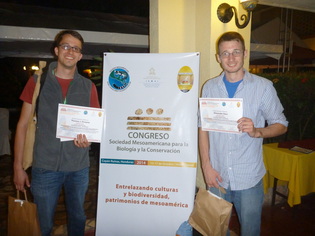
18th Congress of the Society of Mesoamerican Biology and Conservation in Copan Ruinas, Honduras
Joe Townsend, Ileana Luque, TJ Firneno, Alex Hess, Gretchen McCormick, and Kayla Weinfurther attended and presented at the 18th Congress of the Society of Mesoamerican Biology and Conservation, held from 13-18 October 2014 in Copan Ruinas, Honduras. We organized the symposium "Promoting Protection of At-Risk Habitats through Priority Species Conservation", sponsored by the IUP College of Natural Sciences and Mathematics and featuring speakers from US Forest Service, IUP, University of Florida, and universities and institutions in Honduras, El Salvador, Costa Rica, Mexico, Colombia, and Cuba. Joe presented the keynote talk "Promoviendo la Conservación de los Bosques Nublados Amenazados en el Bloque Chortís a través de Inventarios Filogenético", and TJ, Alex, Gretchen, and Kayla all presented posters, with TJ and Alex winning first and second place in the graduate poster competition, respectively. Check out the news item on the IUP website here.
Joe Townsend, Ileana Luque, TJ Firneno, Alex Hess, Gretchen McCormick, and Kayla Weinfurther attended and presented at the 18th Congress of the Society of Mesoamerican Biology and Conservation, held from 13-18 October 2014 in Copan Ruinas, Honduras. We organized the symposium "Promoting Protection of At-Risk Habitats through Priority Species Conservation", sponsored by the IUP College of Natural Sciences and Mathematics and featuring speakers from US Forest Service, IUP, University of Florida, and universities and institutions in Honduras, El Salvador, Costa Rica, Mexico, Colombia, and Cuba. Joe presented the keynote talk "Promoviendo la Conservación de los Bosques Nublados Amenazados en el Bloque Chortís a través de Inventarios Filogenético", and TJ, Alex, Gretchen, and Kayla all presented posters, with TJ and Alex winning first and second place in the graduate poster competition, respectively. Check out the news item on the IUP website here.

Stunning new species of palm-pitviper named for slain Honduran conservationist
A remarkable new species of bright green palm-viper, Bothriechis guifarroi, has been described from a threatened cloud forest in Honduras, and is named to honor grassroots conservationist Mario Guifarro, who was assassinated in 2007. Despite being superficially similar to other Honduran palm pitvipers, the closest relative to the new species lives over 600 km to the south in Costa Rica. The study was published in the open access journal ZooKeys, and can be downloaded here. The IUP News Release can be seen here.
Read more about Mario Guifarro here.
Coverage of this story via Scientific American, National Geographic, Science Daily, Wildlife News, Science World Report, Monga Bay, from Venezuela, Russia, Bulgaria, Slovakia, China, the Netherlands, and Indonesia.

New species of dichromatic moss salamander discovered in northeastern Honduras
A new species of moss salamander (genus Nototriton) is described from Montaña de Botaderos National Park in northeastern Honduras. The new species, Nototriton mime, is the first member of the genus known to exhibit sexual dichromatism, with males (top photo) being a pale yellow-brown and females (bottom photo) a darker mottled brown color that is typical of other species of Nototriton. The study was published in the journal Zootaxa, and the article is available here.
Currently the species is known only from the highest portion of Montaña de Botaderos, in a patch of cloud forest less than 300 hectares in total extent, and we estimate that less than 1,000 hectares of potential habitat is available to N. mime in about a dozen isolated cloud forest fragments.
This new species is named to honor our late friend Arquimides Gabriel Rosales Martinez, or “Mime” (pronounced me-may), a young Honduran biologist passionate about amphibians. Mime and his sister, Novy Hortensia Rosales Martinez, were killed by a drunken driver on 17 December 2010 in Tegucigalpa.
A new species of moss salamander (genus Nototriton) is described from Montaña de Botaderos National Park in northeastern Honduras. The new species, Nototriton mime, is the first member of the genus known to exhibit sexual dichromatism, with males (top photo) being a pale yellow-brown and females (bottom photo) a darker mottled brown color that is typical of other species of Nototriton. The study was published in the journal Zootaxa, and the article is available here.
Currently the species is known only from the highest portion of Montaña de Botaderos, in a patch of cloud forest less than 300 hectares in total extent, and we estimate that less than 1,000 hectares of potential habitat is available to N. mime in about a dozen isolated cloud forest fragments.
This new species is named to honor our late friend Arquimides Gabriel Rosales Martinez, or “Mime” (pronounced me-may), a young Honduran biologist passionate about amphibians. Mime and his sister, Novy Hortensia Rosales Martinez, were killed by a drunken driver on 17 December 2010 in Tegucigalpa.

Krygeris presents Ptychohyla research at PASSHE-STEM Conference in Slippery Rock University
Lab members Alex Hess and Ellen Teygart present at 9th Regional Science Consortium Research Symposium
Townsend and Paso Pacifico receive grant from U.S. Fish and Wildlife Service "Amphibians in Decline" Program
Melissa Medina wins best graduate poster at 44th Meeting of the Commonwealth of Pennsylvania University Biologists
New Species of Centipede Snake Described by Townsend, Medina, and collaborators
Melissa Medina and Catie Krygeris recognized during IUP Research Appreciation Week
The Penn: IUP Professor Monitors Endangered Species
Melissa Medina gives seminar to College of Natural Sciences and Mathematics at IUP
The Penn: IUP Professor Uncovers New Species in Honduras
Townsend and Colleagues Promote Conservation of Critically Endangered Species in Honduras
Townsend Leads International Team Investigating Honduran Cloud Forest Biodiversity, Publishes Two Studies
La Tribuna: Honduras con mayor biodiversidad endémica en Centroamérica
La Tribuna: Dos nuevas especies descubiertas en un hábitat en disminución
La Prensa: Hallan rara serpiente ciega en Santa Bárbara
La Tribuna: En Honduras descubren la serpiente ciega más grande de Mesoamerica
Lab members Alex Hess and Ellen Teygart present at 9th Regional Science Consortium Research Symposium
Townsend and Paso Pacifico receive grant from U.S. Fish and Wildlife Service "Amphibians in Decline" Program
Melissa Medina wins best graduate poster at 44th Meeting of the Commonwealth of Pennsylvania University Biologists
New Species of Centipede Snake Described by Townsend, Medina, and collaborators
Melissa Medina and Catie Krygeris recognized during IUP Research Appreciation Week
The Penn: IUP Professor Monitors Endangered Species
Melissa Medina gives seminar to College of Natural Sciences and Mathematics at IUP
The Penn: IUP Professor Uncovers New Species in Honduras
Townsend and Colleagues Promote Conservation of Critically Endangered Species in Honduras
Townsend Leads International Team Investigating Honduran Cloud Forest Biodiversity, Publishes Two Studies
La Tribuna: Honduras con mayor biodiversidad endémica en Centroamérica
La Tribuna: Dos nuevas especies descubiertas en un hábitat en disminución
La Prensa: Hallan rara serpiente ciega en Santa Bárbara
La Tribuna: En Honduras descubren la serpiente ciega más grande de Mesoamerica








